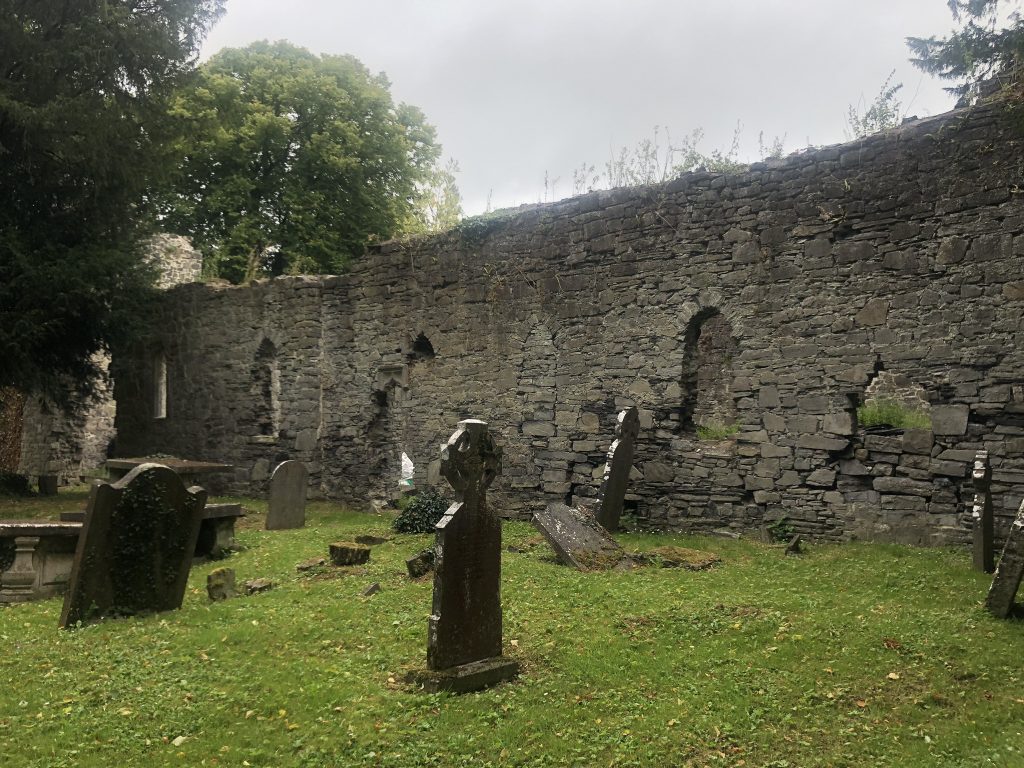Guiding you through Maynooth, past and present
One of the reasons I chose to study at Maynooth University was because it is right next to a castle. It might sound silly, but my one stipulation when choosing where to study in Ireland was a school that had old buildings and a long history. While pretty much all of the schools I considered had beautiful and historic architecture, but Maynooth stood out for me. A town on the outskirts of Dublin would be perfect for a small-town Canadian girl who has never lived in a city. At first, the castle was just a bonus, but it has since become a staple of my everyday life in Maynooth. I walk past it every day, have learned about it in my classes, and during the summers when the grounds are open walk around the grounds.

As someone studying medieval history I have had the privilege of learning about the history of the castle, and the long importance Maynooth has held in the landscape. However, I realize not everyone has the same resources, especially those who don’t study history. So, I thought I’d offer you a tour of the medieval sites around Maynooth and highlight the significance they once held. Where I can tell you about what I am most interested in, the medieval history of Ireland, and, well, castles.
Maynooth Castle
Since I’ve already mentioned the castle why not start your tour there! Be aware the grounds are only open from May to September, but even just seeing the castle from the outside is quite impressive. The general overview of the castle is that it was built in the thirteenth century after the Anglo-Normans invasion of Ireland, the castle was inhabited by the Fitzgerald family from its construction. As you enter the castle grounds, look up at the gate tower and you’ll spot the Fitzgerald family’s coat of arms, just one of the many relics they left behind. From the thirteenth century the Fitzgerald’s grew in prominence, wealth and influence, their family eventually claiming the earlship of Kildare and the role of Lord deputy of Ireland to the King, essentially controlling the English elite in Ireland. At this point the Irish followed their own laws, often clashing with the ‘old English’ – a term used for the Norman settlers. The family would however fall out of favour with the infamous King Henry VIII, completely losing their position after Silken Thomas led a rebellion against the English, but was defeated at Maynooth castle, his family fleeing, and Thomas executed for treason.

Yet, this was not the end for the Maynooth Fitzgeralds or their rebellious spirit; they continued to appear in history, sometimes alongside or against famous English monarchs such as Queen Elizabeth I and King George III. Today, the castle, as it stands, is just a glimpse of what it once was. The keep, the tallest surviving part of the complex, sits on the oldest part of the castle. Over its 500 years of occupation, there were numerous additions and renovations. If you have the chance, I highly recommend visiting the keep, which has been renovated and presents the long history of the castle, along with a model of what it may have looked like in its prime. The castle was abandoned in the 1650s during the Cromwellian conquest of Ireland, and the Fitzgeralds then took up residence in Carton House, continuing to support and build up the town of Maynooth into the twentieth century.


The Ancient Highway
While the castle, located in the centre of town, is an obvious place to see how ancient Maynooth is, there are older, more hidden histories in the area. You may or may not have heard of the ‘ancient highways’ that once crisscrossed Ireland, used as far back as the Bronze Age. One of these roads, the Slige Mór, also called the Eiscir Riada, runs very close to Maynooth! Stretching from Dublin to Galway Bay, it followed gravel ridges that allowed travellers to traverse the difficult landscape and bogs safely. While this ancient road has been overtaken by more modern ones, it’s a testament to just how ancient Maynooth is. The idea that people have been walking through this area for thousands of years is incredibly cool!
Though Maynooth was not established as a town until the Anglo-Normans arrived, it was much more than just a field before that. People lived in the area for hundreds of years before the Fitzgeralds. In fact, the name Maynooth, or Maigh Nuadhad in Irish, comes from a much earlier tradition. The Irish name translates to the ‘plains of Nuadha,’ referring to Nuadha, a mythological king of Ireland in 110 B.C. and sometimes considered an ancestor of the legendary hero Fionn MacCumhaill. If he was a real figure, it is said that he had a fortress in the Maynooth area. He has also been connected to Conn of the Hundred Battles, a famous king featured in many early Irish tales, including the story of the division of the Irish counties in the second century. While there are no physical remains of Nuadha’s fortress, his name lives on across Maynooth—you just have to pay attention to the street signs.
Laraghbryan and other churches
Although Nuadha’s fortress is no longer visible, you can still visit some ancient church sites that remain in the landscape. Laraghbryan, a very old church about a 10-minute walk down Kilcock Road (which runs between North and South Campus), has been in this spot since at least the seventh century, originally as a monastery, later converted into a church with the arrival of the Normans. While the building as it stands now isn’t from the seventh century, you can see that it was built on a circular mound, a characteristic of early monasteries and settlements in general. Today, you’ll find a large stone church in ruins, complete with a tower and a spiral stone staircase (though a door now prevents you from entering the tower). The church is in a graveyard, so please be respectful if you choose to visit.

While Laraghbryan is within walking distance, there are other ancient religious sites in the area, one of which you can see from the train to Dublin. As you leave Maynooth, look to the south and you’ll spot a round graveyard in the middle of a field. This is Grangewilliam, where the church of Donaghmore once stood. Interestingly, I found some mentions that Saint Patrick himself may have stopped at this church for rest during his journeys—though we can’t be sure. What fascinates me most about this site is the discovery of an Ogham stone by one of the residents of Carton in 1902. If you’re unfamiliar, Ogham is an ancient writing system developed in Ireland around 200-300 A.D. Most of the evidence we have of it comes from notches etched on rocks, usually indicating names of people or places. Cool, nonetheless. While this particular Ogham stone isn’t available for public viewing, you can see others in the National Archaeology Museum. I haven’t visited Donaghmore myself, and since it’s on private property, I wouldn’t recommend going there, but you can get a fairly good view from the train.

The end
This tour, guide, history, or whatever you want to call it, is just a very small overview of a very long and sometimes complex history, especially regarding the Earls of Kildare. If you want to learn more, I recommend Mary Cullen’s Maynooth: A Short Historical Guide, Colm Lennon’s Sixteenth Century Ireland: The Incomplete Conquest, and the Irish Towns Atlas entry on Maynooth. You can find all of these in the library. As an international student from Canada, being surrounded by the history I’ve been studying has been an incredible experience. I hope this ‘tour’ wasn’t too boring, and if you get the chance before it closes, please visit Maynooth Castle.
Sources: Horner, Arnold, ‘Maynooth’ in Irish historic towns Atlas no.7 (1995); Cullen, Mary, Maynooth (Maynooth, 1979); Lennon, Colm, Sixteenth Century Ireland: The Incomplete Conquest (Dublin, 1994); O Lochlainn, Colm, “Roadways in ancient Ireland”, in: John Ryan (ed.), Féil-sgríbhinn Eóin Mhic Néill: Essays and studies presented to professor Eoin MacNeill on the occasion of his seventieth birthday, May 15th 1938, (Dublin, 1940), pp 465–474.






This was a very interesting read detailing some of the history of Maynooth and introducing me to some of the other sites in the area and you included some references to help me explore more of the history of Ireland Not boring made me want to explore more about the history of Ireland.
Thanks
Very well written! Maynooth is truly a magical place!